What Cables Do I Need for Dual Monitors? – Simplified
Did you know there are more than five types of cables with different connectors used for monitors?
If you are setting up dual monitors, chances are you’re looking for ways to connect them, and that’s where the type of cables comes into play.
In this post, I will explain the cables you need for your dual monitors.
What Cables do I need for Dual Monitors?
In a nutshell, what decides the cables are needed for a dual monitor setup is depends on the type of connecting port available on your monitor and your computer (Laptop/Desktop). Common connections include HDMI, Display Port, DVI, and VGA.
Check both your monitors’ and laptops’ ports to identify which cables you need. In the case of desktop computers, note that the graphics processing unit (GPU) is crucial for handling multiple monitor setups, so checking its ports is essential.
Also, if your laptop or desktop’s GPU has only one port, you can only connect one monitor. In order to have a two monitors environment, you will require two separate connectors. This is because each monitor needs its dedicated connection to display.

If you find two or more ports on your computer, it’s a good indication that you can connect additional monitors to it.
It’s worth mentioning – that some GPUs support multiple monitors even through a single connection using technologies like DisplayPort daisy chaining or HDMI splitters (more on this later ahead).
Now to give you clear idea, let’s dive into the types of cables with images commonly used for dual monitors to help you make the right connections.
Types of cables you can use for dual monitors
VGA (Video Graphics Array)
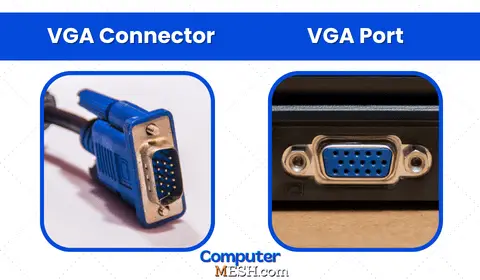
VGA, also known as D-sub, has 15 pins arranged in three rows, typically blue. It is analog and is capable of supporting resolutions up to 1080p. However, they are becoming less popular as newer and better options are available.
HDMI (High Definition Multimedia Interface)

HDMI is popular because of its high bandwidth capabilities, allowing for higher resolutions and faster data transfer rates than VGA. It has 19 pins arranged in three rows and is usually black in color.
HDMI’s latest versions can support resolutions up to 8K and also carry audio signals. The majority of PCs and modern monitors come with HDMI ports.
DVI (Digital Visual Interface)
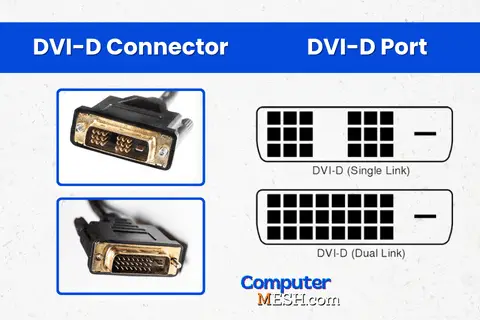
DVI is similar to HDMI in functionality but has a different connector design. They can also support resolutions up to 4K, depending on the type of DVI port (DVI-D or DVI-I). DVI cables have either 24 pins arranged in three rows (DVI-D) or 29 pins arranged in four rows (DVI-I).
A reason not to choose VGA and DVI ports for a dual monitor setup is that they do not support audio signals, so if your monitor has an inbuilt speaker, it won’t deliver audio. Moreover, they are less versatile and efficient than HDMI. Other reasons could be limited resolution capabilities compared to HDMI and DisplayPort.
DisplayPort

DisplayPort is a digital cable with high bandwidth capabilities similar to HDMI. It has 20 pins arranged in two rows and can support resolutions up to 8K. DisplayPort is commonly used for gaming and other high-performance applications.
USB-C (Universal Serial Bus Type-C)
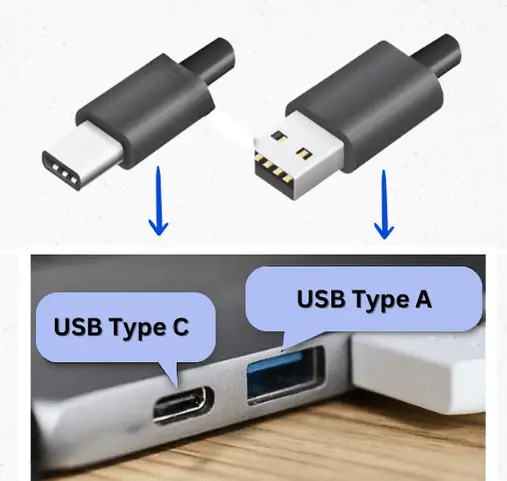
USB-C is a versatile digital cable that can carry both video and audio signals, data, and power. It has 24 pins arranged in two rows and is becoming more popular with newer computers and monitors. USB-C can support resolutions up to 4K and has the added benefit of charging devices.
Thunderbolt
Thunderbolt is a high-speed one that combines data, video, and power capabilities. It has 20 pins arranged in two rows and can support multiple 4k displays with a single cord. Thunderbolt is commonly used in Mac computers and is becoming more prevalent in Windows.
Last Step
Now that you are familiar with the different types of cables commonly used. Check what port is available on your monitor to confirm the same kind of port is available on your computer.
It is necessary to match the terminals on both the computer and display sides for compatibility with no issues.
For example, if your monitor has a VGA port, you will need a VGA cable to connect it to your computer’s VGA port. Similarly, if your computer has a Displayport, you will need an Displayport cable to connect it to your computer’s Displayport.
What to do when there is No Matching port available?
Sometimes, the port on the computer side is already occupied with the first monitor, and the second monitor doesn’t have any matching port left.
For example, a common scenario is when a desktop with only one HDMI port is already connected to a monitor, leaving no available HDMI for a second monitor.
Similarly, it can happen with laptops with many HDMI or DisplayPort ports, but none are available on the additional monitor.
In any case, there is no need to give up just because they don’t match perfectly. You can use an adapter or conversion cable to bridge the gap.
What are Adapters?
Adapters are small cables with different ports on each end, allowing you to connect two devices with different ports. For example, a HDMI to VGA adapter will allow you to connect a monitor with a HDMI port to a computer with an VGA port.
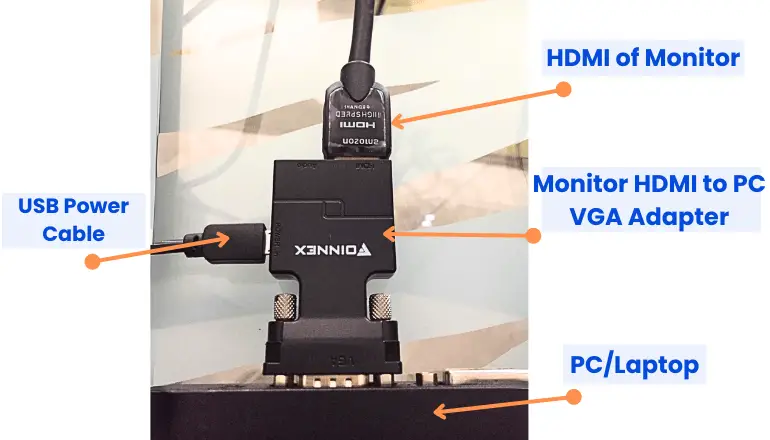
This is how you can resolve and match ports when required, using adapters to make the connection possible.
It is important to note that using an adapter may impact the display’s quality or capabilities, such as refresh rate and resolutions. However, it is a useful option when no matching ports are available.
Adapters are widely available for the various types of connections above explained that can be purchased online or at electronics stores.
- HDMI to VGA
- HDMI to DisplayPort
- HDMI to DVI
- DisplayPort to VGA
- DisplayPort to DVI
- VGA to DVI or HDMI
HDMI Splitters and DisplayPort Daisy Chaining
Another option to consider when dealing with multiple monitors and limited ports is an HDMI splitter or DisplayPort daisy chaining.
An HDMI splitter is a device that splits a single HDMI cable coming from your computer side into multiple HDMI ports, letting you connect more than one monitor even if your computer only has one HDMI port.
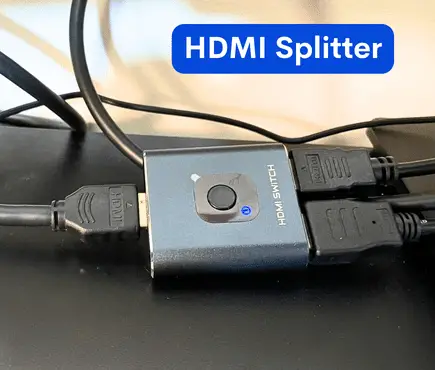
It may also be necessary to adjust settings or use specific versions of HDMI when using splitters. As always, it is recommended that you read the product manual.
If you’re working with high-resolution displays or high refresh rates, make sure the HDMI splitter supports the specifications you need. Some older or budget splitters may not keep 4K resolutions or best refresh rates.
Similarly, DisplayPort Daisy chaining is a technology that allows you to connect multiple monitors using only one DisplayPort cable coming from your computer’s side. It works by linking the first monitor to the second and then the second to the third, creating a chain of monitors connected in series.
And yes, all your monitors must support DisplayPort 1.2 or higher, and you will need a computer with a DisplayPort output to make this work.
Both options are great for those with limited ports but who want to use multiple monitors without adapters or converters.
Final Words
In conclusion, there are several options available to connect multiple monitors to your computer, from using adapters to HDMI splitters and DisplayPort daisy chaining.
With these solutions, you can easily expand to two screens or even more and improve productivity without having to invest in a new computer or monitor with multiple ports.
So next time you face the challenge of cables for dual monitors, remember that there are ways to make it work even there is limitations with PC system. So, if you haven’t made your computer dual display yet, I’m sure you’ll find it useful, so give it a try!
[Related]
